Composition
by Michael Frye | Jun 7, 2019 | Composition
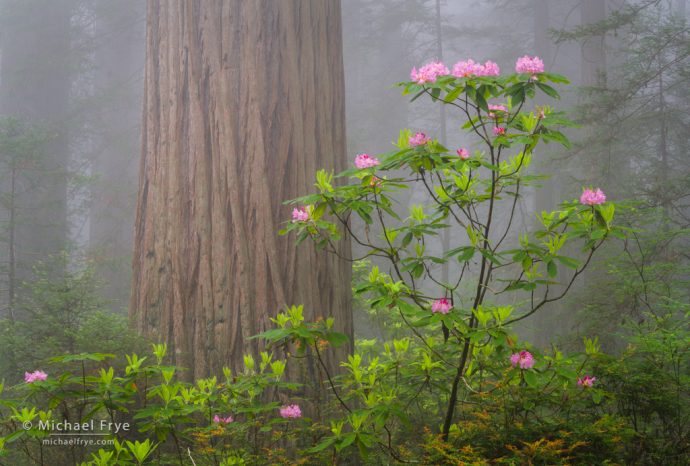
Redwood and rhododendron in the fog, northern California. 90mm, 1.5 seconds at f/16, ISO 400, polarizer.
When teaching composition I emphasize simplicity, because I think the single most common mistake people make is including too much in the frame. I tell students to ask themselves, before composing a photograph, what caught their eye in the first place, and then try to include only that, and nothing else. Pare the image down to its essentials.
The more specific you can get the better. In other words, if a tree caught your eye, what is it about that tree that you find interesting? It’s shape? It’s color? The juxtaposition between the tree and something else? Part of the tree rather than the whole thing? Does something about the tree convey a feeling to you? If you can identify exactly what drew you to a subject or scene you’ll know what you’re trying to say, which is the first, essential step toward effective communication.
(more…)
by Michael Frye | May 26, 2019 | Composition
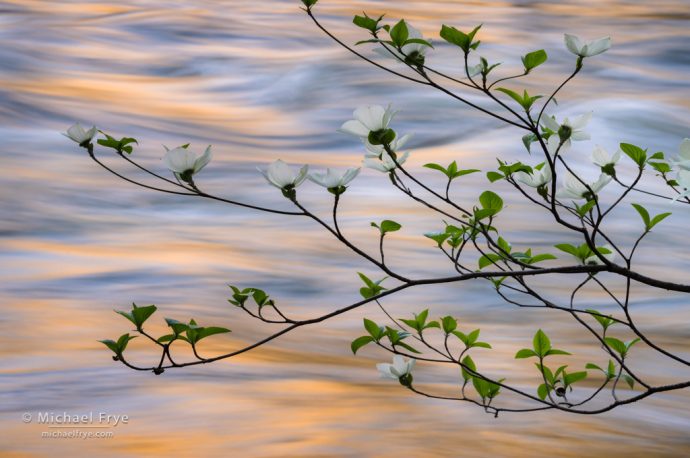
Dogwood and golden reflections, Yosemite. A telephoto lens (116mm) helped simplify the scene by isolating one small section of branches against the water. 1/4 second at f/22, ISO 100.
Claudia and I are up in the redwood country, scouting for our upcoming workshop. I’ll post some photos from this area later, but in the meantime here are a few more dogwood images from Yosemite.
One of the biggest challenges when photographing forest scenes, including dogwoods, is simplifying and organizing all the chaos. Trunks, branches, leaves, and shrubs are scattered about, growing where there’s sunlight and suitable soil. There’s an order to all that, but it’s an organic order that doesn’t translate easily into visual order. To find compositions that make sense, you have to look for ways to simplify these scenes.
(more…)
by Michael Frye | May 7, 2019 | Composition
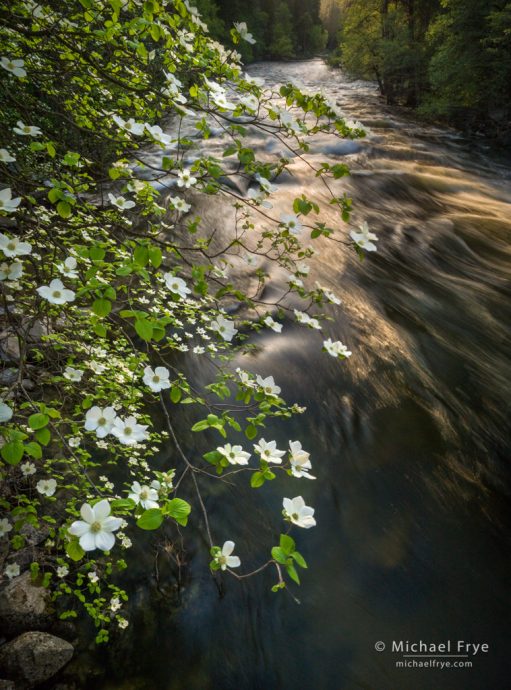
Dogwood and late-afternoon light along the Merced River, Yosemite
While the big wildflower blooms in southern California are now well past peak, spring keeps progressing into cooler regions, like the mountains. It’s been a good year for dogwoods, and Claudia and I have had a few opportunities to photograph them over the last couple of weeks.
Most of my dogwood photographs have been made with telephoto lenses in soft light. The scene above didn’t fit that description at all, with a close foreground that seemed to demand a wide-angle lens, and late-afternoon sunlight streaming down the river, creating lots of contrast. But the backlight looked beautiful – and besides, I’ve photographed dogwoods many times, so I was in the mood to push myself and do something different.
(more…)
by Michael Frye | Apr 21, 2019 | Composition
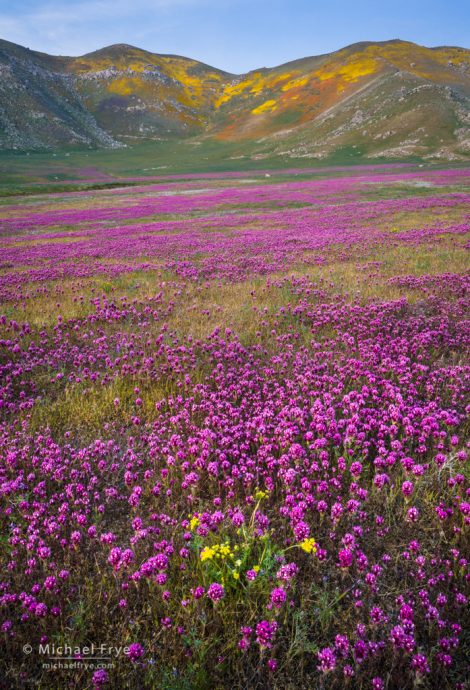
Poppies, goldfileds, owl’s clover, and spring gold, southern Sierra Nevada, California. There were two compositional challenges here: the physical distance between the foreground and background flowers, plus the lack of any distinguishing features in the foreground that could serve as a focal point. I found this slightly-elevated vantage point where I could show the sweep of owl’s clover leading up to the hills, allowing me to fill most of the frame with flowers, so that solved the first problem. And then I spotted this small clump of yellow flowers (spring gold), which added a foreground focal point, and tied in visually with the yellow colors in the background. 27mm, 1/10th of a second at f/16, ISO 800.
It’s been a good year for wildflowers in California – above average in some places, and exceptional in a few spots.
One of those places that seemed to be having an exceptionally-good year was Antelope Valley, so after our Death Valley workshop Claudia and I made a quick trip down there. We had seen poppies in Antelope Valley back in the late ’80s, but hadn’t been back since, so this seemed like a good time for a return visit. And the flowers were amazing. In the sun the combination of bright, red-orange poppies and yellow goldfields was downright blinding. It actually hurt my eyes to look directly at the flowers.
(more…)
by Michael Frye | Oct 14, 2018 | Composition, Travels and Stories

Aspen kaleidoscope, Uncompahgre NF, CO, USA
Claudia and I made our annual pilgrimage to Colorado to see the aspens, with a short detour into some Utah canyons. We’ve actually been traveling for three weeks, and just got home. During our trip we got up before sunrise almost every morning, and stayed out until after sunset nearly every evening. I kept thinking that I should post some photos, but there always seemed to be some interesting weather, and photos to be made, and barely enough time to eat, sleep, and then get up at 5:30 and do it all over again.
(more…)
by Michael Frye | Jul 19, 2018 | Composition, Yosemite Photo Conditions
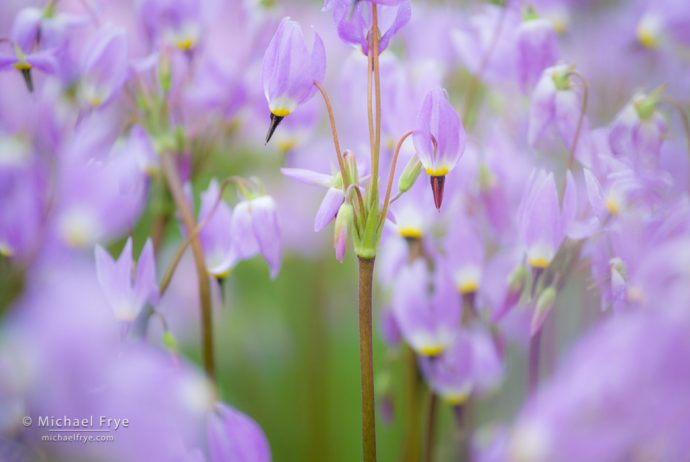
Shooting stars, summer wildflowers, Yosemite. Handheld (a rarity for me) at 1/200th sec., f/4, ISO 400. I’m almost always using medium to small apertures to get everything in focus, but once in awhile it’s fun to use a wide aperture to throw the foreground and background out of focus.
I just finished teaching a workshop, so I’m catching up on posting images from earlier this summer. As I mentioned in a recent post, Claudia and I made several trips in June to the higher elevations of Yosemite to look for wildflowers. We found many shooting stars, which are one of the early bloomers in the high country. They’re beautiful flowers, but they always grow in marshy areas, full of mosquitos. So over the years my brain has made an association between shooting stars and their accompanying insect pests, and just seeing these flowers triggers a psychological reaction that literally makes me itch.
But aside from that initial visceral reaction to the sight of shooting stars, mosquitos don’t generally faze me much. I’ve actually developed a partial immunity to the mosquitos in Yosemite, so bites don’t create welts or make me itch anymore. Mosquitos are still annoying, but a little insect repellent keeps them at bay and lets me concentrate on photographing flowers.
(more…)














